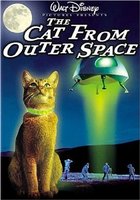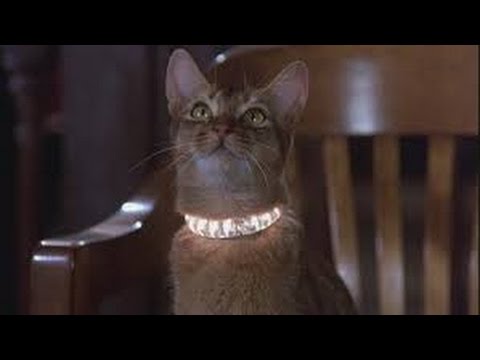
As we see a feline descend from the tongue-like walkway of a cat-shaped spaceship, Disney’s 1978 film The Cat From Outer Space opens, invoking a science-fiction both familiar and alien. It is difficult to not subscribe to the film’s endearing nature of a developed animal companionship as a bond forms between human and cat that goes beyond the ordinary. However, beyond the light-heartedness of a talking cat attempting to fix his spaceship lies an examination of contemporary American male sexuality.
An intimate relationship grows between Frank (Ken Barry) and the title character, Jake. In From Mouse to Mermaid Brian Attebury looks at this “relaxed and pleasurable” relationship, juxtaposing it against the romantic scenes between Frank and Liz (Sandy Duncan) which are “awkward”.[1] This examination finds grounding in the first scene within Frank’s apartment, providing traction by which the male sexuality can be explored.
Upon a basic level, anthropomorphism is apparent. Jake can talk and interact with Frank, as within the film his is ascribed human characteristics. However, what is most pressing about this ascription of human qualities is that, within the film, they are not contrived by a human. Jake seemingly takes the human characteristics, and his own employment is what constructs Frank’s awe. We see in his manipulation of common phrases, like “you rub my fur, I rub yours”, that he appropriates the human construct of language, only adding to the superiority which he establishes. The film recognises the human as autonomous, yet this theft which Jake carries out destabilises this. Of course, the mise-en-scene (figure. 1) similarly reflects such anthropomorphic qualities, as Jake sits on a chair and invites Frank to join him, mirroring a conventional business scene.

(figure. 1)
Frank’s awe of Jake runs parallel to his dismissiveness of Liz, as he instructs her to “butt out!”. The fulfilment of a heterosexual partnership is satisfied, as Jake appears to fulfil the role. Whilst not romantic, the intimacy between man and animal is apparent, with phallic connotations certifying Frank as the male, expressing his interest in the relationship. The common gendering of the cat species as female only adds to this, alongside the crystal collar which Jake wears, echoing Cinderella’s glass slipper. [2] The collar replaces the magic of Cinderella with science, speaking to contemporary audience still in the aftermath of a moon landing. [3] Jake provides Frank with the ability to further his mind, something which Liz does not propose.
Therefore, whilst the film gives us a cat that can talk through brain power, the removal of the human ownership of the construct of language reveals the contemporary male obsession with that which can further the mind, allowing for an examination of the selfishness of the male within relationships. The female is rendered obsolete, simply as a result of the arrival of a cat from outer space.
References
[1] Brian Attebury, ‘Beyond Captain Nemo’, in From Mouse to Mermaid, ed. by Elizabeth Bell, Laura Sells, Lynda Haas(Indiana: Indiana University Press, 1995), p. 157.
[2] Brian Attebury, ‘Beyond Captain Nemo’, in From Mouse to Mermaid, ed. by Elizabeth Bell, Laura Sells, Lynda Haas(Indiana: Indiana University Press, 1995), p. 157.
[3] Tom Buckley, The Cat From Outer Space (1978) (2016) <http://www.nytimes.com/movie/review?res=9A0DE4DF1E31E632A25753C3A9609C946990D6CF> [accessed 11 January 2016].